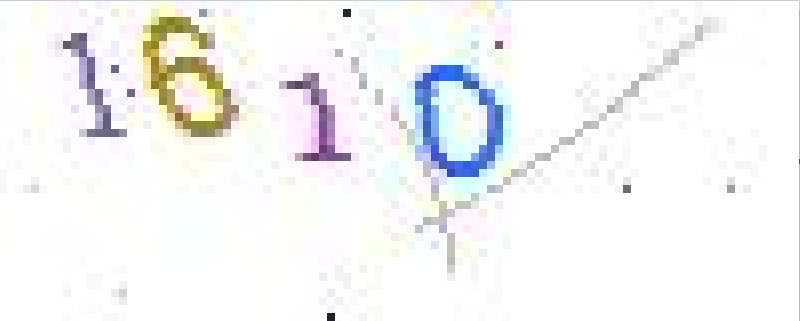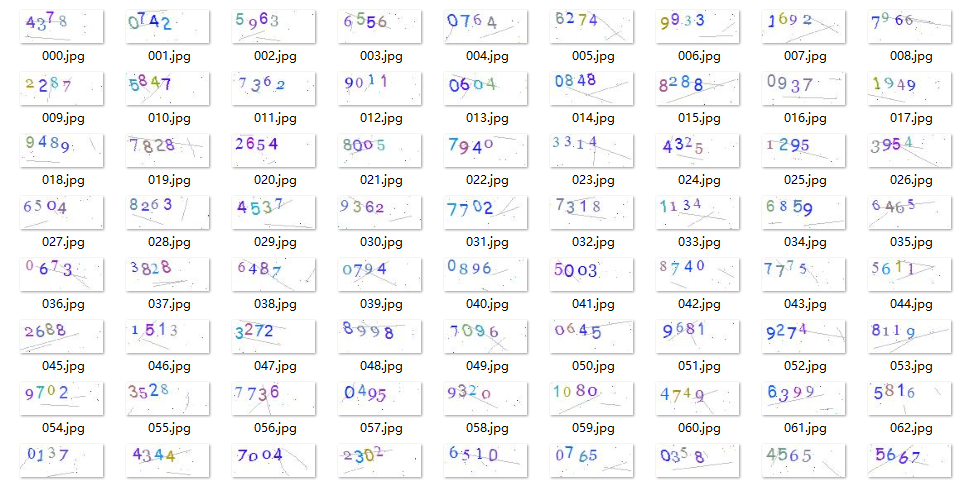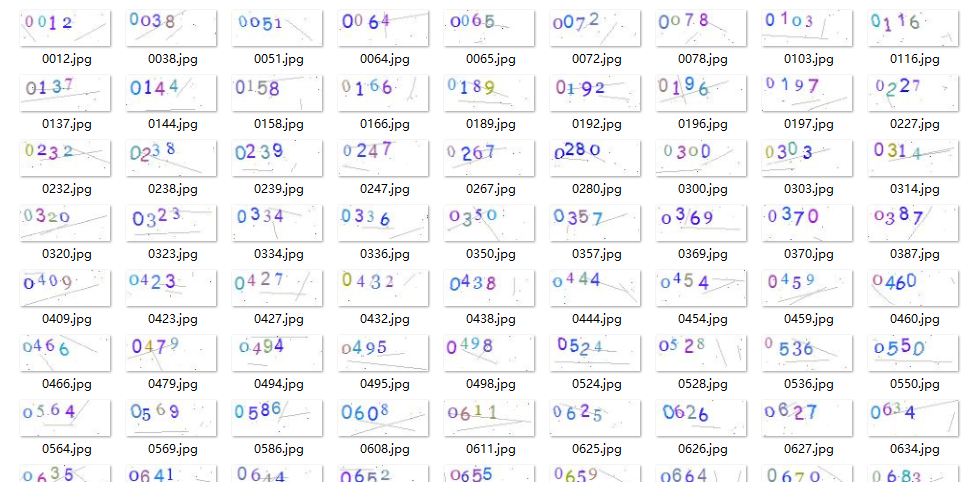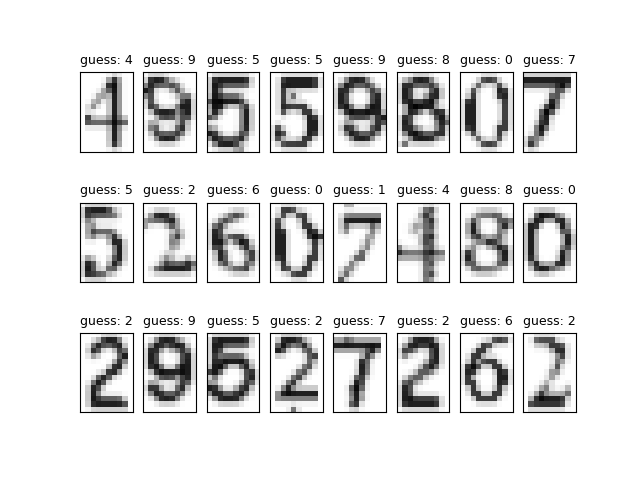此前虽也做过不少验证码识别的项目(比如微班安全教育和 iSmart 以及智学网的登录),但这些东西图形都比较简单,只用简单的模板匹配就能达到很高的识别率,所以一直也就这么用着,直到有一天碰到了硬点子……
这网站的验证码长这样:
随机的颜色、随机的位置、随机的扭曲度、随机的字号……让传统匹配算法有些力不从心,之前虽然有过用 Tesseract 成功识别的案例,不过一是识别率不够高,二是移植脚本时还要额外安装 Tesseract(不同平台的安装方法还不同),感觉怪麻烦的,思来想去……感觉核心技术还是要掌握在自己手中,如果能打造一款针对这个网站设计的验证码识别脚本,应该可大大提升识别的效率和准确度。
准备工作
说干就干,首先设计好框架,神经网络应该只具备单个字符识别的功能,这样会更有利于训练,所以需要先用一些简单的预处理算法将 4 字符的验证码切分为 4 张等大的图片,再分别交给网络进行识别,最后将结果整合起来,作为识别的结果。
将验证码切分为字符
那么先从最简单的切分部分开始,下载 1000 张验证码图片作为模板和测试用例:
1 2 3 4 5 6 7 8 9 10 11 12 13 14 15 16 17 18 19 20 21 22 23 24 25 26 27 28 29 30 31 32 33 34 35 36 37 38 39 40 41 42 43 44 45 46 47 import asynciofrom random import randintfrom time import timeimport httpxfrom loguru import loggerdef get_uuid (): return f'{time()*1000 :.0 f} {randint(100 , 999 )} ' async def download_image (count ): client = httpx.AsyncClient() limit = asyncio.Semaphore(4 ) async def internal (): async with limit: try : token = ( await client.get('https://fangkong.hnu.edu.cn/api/v1/account/getimgvcode' ) ).json()['data' ]['Token' ] image = await client.get(f'https://fangkong.hnu.edu.cn/imagevcode?token={token} ' ) except Exception as err: logger.error(repr (err)) return path = f'../data/raw_image/{get_uuid()} .jpg' logger.info(f'File saved to: {path} ' ) with open (path, 'wb' ) as fp: fp.write(image.content) await asyncio.gather(*[internal() for _ in range (count)]) await client.aclose() async def main (): await download_image(1000 ) if __name__ == '__main__' : loop = asyncio.new_event_loop() try : loop.run_until_complete(main()) finally : loop.close()
从模板的内容来看,大部分的文字都位于验证码图片的左上角,自然而然的会想到先对验证码进行裁剪预处理,但究竟需要裁多大一块区域呢?我用一个脚本对所有图片进行了灰度化和叠加处理:
1 2 3 4 5 6 7 8 9 10 11 12 13 14 15 16 17 18 19 20 import osimport cv2import numpy as npimport matplotlib.pyplot as pltoverlay = None files = os.listdir('../data/raw_image' ) for file in files: image = cv2.imread(f'../data/raw_image/{file} ' ) image = cv2.cvtColor(image, cv2.COLOR_RGB2GRAY) if overlay is None : overlay = np.zeros(image.shape) overlay += image if overlay is not None : overlay = overlay * 255 / np.max (overlay) plt.imshow(overlay) plt.show()
最终结果显示:99% 的数字都出现在左上角 67*27 的区域中,所以我们提前裁剪这块区域,以减少后期的计算量
难点来了!如何让程序将不同的字符区分出来,成为一个值得研究的问题。传统的方法是统计每一竖排上黑色像素的数量(想象一张柱状图),然后采用一根扫描线自下而上不断扫描,直到扫描线上方的「柱状图」连通块数量第一次为 4(即字符数量),但在字符随机倾斜的情况下,继续沿用这样的方法非常容易产生切割错误的问题,我们需要一种更有效的算法来进行字符切分
观察二值化后的验证码,发现每个字符的各个像素之间的关联性并不强,甚至有些字符简直可以用「支离破碎」来形容,这意味着如果直接进行搜索,将很容易出现错误。所以考虑首先使用 3×5 的算子对图片进行高斯模糊处理,然后再进行一次二值化,从而将每个字符「粘连」起来,处理之后的图片长这样:
差不多就要开始切分了,首先对上一步得到的图像进行深度优先搜索,找出所有连通量在 20~150 的黑色像素连通块并进行标记,最后进行一次判断,如果找到符合条件的像素块(即字符)数量为 4,则按照记录进行切分,将每个字符缩放到 10×15px 的区域并置中,最后做一次 3×3px 的高斯模糊:
1 2 3 4 5 6 7 8 9 10 11 12 13 14 15 16 17 18 19 20 21 22 23 24 25 26 27 28 29 30 31 32 33 34 35 36 37 38 39 40 41 42 43 44 45 46 47 48 49 50 51 52 53 54 55 56 57 58 59 60 61 62 63 64 65 66 67 68 69 70 71 72 73 74 75 76 77 78 79 80 81 82 83 84 85 86 87 88 89 90 91 92 93 94 95 96 97 98 99 100 import osimport cv2import matplotlib.pyplot as pltimport numpy as npDIGITS = 4 WIDTH, HEIGHT = 67 , 27 BINARY_THRESHOLD = 180 BLUR_CORE_SIZE = (3 , 5 ) BLUR_BINARY_THRESHOLD = 210 MIN_BLOCK_SIZE, MAX_BLOCK_SIZE = 20 , 150 DIGIT_WIDTH, DIGIT_HEIGHT = 10 , 15 def mark (image, mask ): shape = image.shape flag = np.zeros(image.shape, dtype=np.uint8) def dfs (x, y, depth, flow ): if 0 <= x < shape[0 ] and 0 <= y < shape[1 ] and mask[x, y] == 0 and not flag[x, y]: flow.append((x, y)) flag[x, y] = 1 count = 1 for way in ((-1 , 0 ), (0 , 1 ), (0 , -1 ), (1 , 0 )): count += dfs(x + way[0 ], y + way[1 ], depth + 1 , flow) return count else : return 0 results = [] for i in range (image.shape[0 ]): for j in range (image.shape[1 ]): if flag[i, j]: continue if mask[i, j] == 0 : pixels = [] if MIN_BLOCK_SIZE <= dfs(i, j, 0 , pixels) <= MAX_BLOCK_SIZE: results.append(( image[ min (x[0 ] for x in pixels):max (x[0 ] for x in pixels), min (x[1 ] for x in pixels):max (x[1 ] for x in pixels) ], sum (x[1 ] for x in pixels) / len (pixels) )) flag[i, j] = 1 if len (results) != 4 : return None results.sort(key=lambda x: x[1 ]) return [x[0 ] for x in results] def split (image ): image = cv2.cvtColor(image[:HEIGHT, :WIDTH], cv2.COLOR_RGB2GRAY) binary = cv2.threshold(image, BINARY_THRESHOLD, 255 , cv2.THRESH_BINARY)[1 ] mask = cv2.threshold( cv2.GaussianBlur(binary, BLUR_CORE_SIZE, 0 ), BLUR_BINARY_THRESHOLD, 255 , cv2.THRESH_BINARY )[1 ] digits = mark(image, mask) if digits is None : return None for i, digit in enumerate (digits): scale = max (digit.shape[0 ] / DIGIT_HEIGHT, digit.shape[1 ] / DIGIT_WIDTH) digit = cv2.resize( digit, (int (digit.shape[1 ] / scale), int (digit.shape[0 ] / scale)), interpolation=cv2.INTER_LANCZOS4 ) height, width = digit.shape background = np.full((DIGIT_HEIGHT, DIGIT_WIDTH), 255 ) left, top = (DIGIT_WIDTH - width) // 2 , (DIGIT_HEIGHT - height) // 2 background[top:top+height, left:left+width] = digit digits[i] = background return digits def main (): path = '../data/raw_image' for file in os.listdir(path): image = cv2.imread(os.path.join(path, file)) if (digits := split(image)) is not None : plt.subplot(2 , 1 , 1 ) plt.imshow(image[:HEIGHT, :WIDTH]) for i, digit in enumerate (digits): plt.subplot(2 , 4 , i+5 ) plt.imshow(digit) plt.show() if __name__ == '__main__' : main()
最终得到的效果如下:
获取训练数据集
接下来开始获取训练用的数据集,首先使用旧的 Tesseract 识别引擎,通过反复识别验证码模拟登陆,同时记录下登录成功时的识别结果,即能得到验证码和数字的对应组合:
1 2 3 4 5 6 7 8 9 10 11 12 13 14 15 16 17 18 19 20 21 22 23 24 25 26 27 28 29 30 31 32 33 34 35 36 37 38 39 40 41 42 43 44 45 46 47 48 49 50 51 52 53 54 55 56 57 58 59 60 61 62 63 64 65 66 67 68 69 70 71 72 73 74 75 76 77 78 79 80 81 82 83 84 85 86 87 88 89 90 91 92 93 import osimport pickleimport reimport subprocess as spimport cv2import httpximport numpy as npfrom loguru import loggerfrom binarize import split, DIGITSfrom spider import get_uuidDATASIZE = 3000 USERNAME, PASSWORD = '# 学号 #' , '# 登录密码 #' MESSAGE_LOGIN_SUCCESS = '成功' class Spider (object def __init__ (self, username, password ): self.client = httpx.Client() self.username = username self.password = password @staticmethod def ocr (image ): proc = sp.Popen(['tesseract' , '-' , '-' ], stdin=sp.PIPE, stdout=sp.PIPE) proc.stdin.write(image) proc.stdin.close() result = re.sub('[^0-9]' , '' , proc.stdout.read().decode()) if len (result) != 4 : return None return result def fetch_captcha (self ): try : token = ( self.client.get('https://fangkong.hnu.edu.cn/api/v1/account/getimgvcode' ) ).json()['data' ]['Token' ] image = self.client.get(f'https://fangkong.hnu.edu.cn/imagevcode?token={token} ' ) captcha = cv2.imdecode(np.frombuffer(image.content, np.uint8), cv2.IMREAD_COLOR) return image.content, captcha, token except Exception as err: logger.error(repr (err)) return None , None , None def verify (self, code, token ): try : result = self.client.post( 'https://fangkong.hnu.edu.cn/api/v1/account/login' , data={ 'Code' : self.username, 'Password' : self.password, 'WechatUserInfoCode' : None , 'VerCode' : code, 'Token' : token } ).json() if result['msg' ] == MESSAGE_LOGIN_SUCCESS: return True logger.info(f'Login failed: {result["msg" ]} ' ) return False except Exception as err: logger.error(repr (err)) return False def run (self, count ): success = 0 while success < count: raw_captcha, captcha, token = self.fetch_captcha() while captcha is None or (code := self.ocr(raw_captcha)) is None or (digits := split(captcha)) is None : raw_captcha, captcha, token = self.fetch_captcha() if self.verify(code, token): success += 1 for i, ch in enumerate (code): with open (f'../data/marked/{ch} /{get_uuid()} ' , 'wb' ) as fp: fp.write(pickle.dumps(digits[i])) logger.info(f'[{code} ] Success.' ) def main (): spider = Spider(USERNAME, PASSWORD) average = sum (len (os.listdir(f'../data/marked/{n} ' )) for n in range (10 )) / DIGITS logger.debug(f'Image count: {average} / {DATASIZE} ' ) spider.run(max (DATASIZE - average, 0 )) if __name__ == '__main__' : main()
挂机请求几个小时 (辅导员摇了我吧,我可是专门挑打卡低峰期来发请求的 qwq) ,下载到了不少验证码:
简单检查一下结果,切分的准确程度超乎我的意料,绝大部分的字符都被准确的分类了,只有极少数出现残缺。接下来,也是整个项目最难的部分,编写神经网络……
原理分析
我设计了一个四层的神经网络,除输入输出层外还包含两个隐含层
输入层有 150 个神经元,两个隐含层分别有16个神经元,输出层的10个神经元分别代表 0~9 的数字,每个神经元的激活值都在 [0, 1) 区间内
假设第 i i i N i N_i N i j j j a i j a_i^j a i j i + 1 i+1 i + 1 k k k
a i + 1 k = ∑ j = 1 N i a i j ⋅ ω i + 1 k j + b i + 1 k a_{i+1}^k = \sum_{j=1}^{N_i}a_i^j\cdot\omega_{i+1}^{kj} + b_{i+1}^k
a i + 1 k = j = 1 ∑ N i a i j ⋅ ω i + 1 kj + b i + 1 k
其中 ω i + 1 k j \omega_{i+1}^{kj} ω i + 1 kj i i i j j j i + 1 i+1 i + 1 k k k b i + 1 k b_{i+1}^k b i + 1 k i + 1 i+1 i + 1 k k k
[ a i + 1 1 a i + 1 2 ⋮ a i + 1 m ] = Ω a i → + b i + 1 → = S i g m o i d ( [ ω i + 1 11 ω i + 1 12 ⋯ ω i + 1 1 n ω i + 1 21 ω i + 1 22 ⋯ ω i + 1 2 n ⋮ ⋮ ⋱ ⋮ ω i + 1 m 1 ω i + 1 m 2 ⋯ ω i + 1 m n ] [ a i 1 a i 2 ⋮ a i n ] + [ b i + 1 1 b i + 1 2 ⋮ b i + 1 m ] ) \begin{bmatrix}
a_{i+1}^1 \\
a_{i+1}^2 \\
\vdots \\
a_{i+1}^m \\
\end{bmatrix}
= \Omega \overrightarrow{a_i} + \overrightarrow{b_{i+1}}
= Sigmoid(\begin{bmatrix}
\omega_{i+1}^{11} & \omega_{i+1}^{12} & \cdots & \omega_{i+1}^{1n} \\
\omega_{i+1}^{21} & \omega_{i+1}^{22} & \cdots & \omega_{i+1}^{2n} \\
\vdots & \vdots & \ddots & \vdots \\
\omega_{i+1}^{m1} & \omega_{i+1}^{m2} & \cdots & \omega_{i+1}^{mn} \\
\end{bmatrix}
\begin{bmatrix}
a_i^1 \\
a_i^2 \\
\vdots \\
a_i^n \\
\end{bmatrix}
+
\begin{bmatrix}
b_{i+1}^1 \\
b_{i+1}^2 \\
\vdots \\
b_{i+1}^m \\
\end{bmatrix})
⎣ ⎡ a i + 1 1 a i + 1 2 ⋮ a i + 1 m ⎦ ⎤ = Ω a i + b i + 1 = S i g m o i d ( ⎣ ⎡ ω i + 1 11 ω i + 1 21 ⋮ ω i + 1 m 1 ω i + 1 12 ω i + 1 22 ⋮ ω i + 1 m 2 ⋯ ⋯ ⋱ ⋯ ω i + 1 1 n ω i + 1 2 n ⋮ ω i + 1 mn ⎦ ⎤ ⎣ ⎡ a i 1 a i 2 ⋮ a i n ⎦ ⎤ + ⎣ ⎡ b i + 1 1 b i + 1 2 ⋮ b i + 1 m ⎦ ⎤ )
Sigmoid 为挤压函数,用于将数轴上的数压缩到 ( 0 , 1 ) (0, 1) ( 0 , 1 )
S i g m o i d ( x ) = 1 1 + e − x Sigmoid(x) = \frac{1}{1+e^{-x}}
S i g m o i d ( x ) = 1 + e − x 1
定义一个代价函数,其值为每个输出激活值与期望值的差的平方和:
C = ∑ i = 1 N − 1 ( a − 1 i − E i ) 2 C=\sum_{i=1}^{N_{-1}}(a_{-1}^i-E_i)^2
C = i = 1 ∑ N − 1 ( a − 1 i − E i ) 2
其中 E i E_i E i
考虑第 i 层的第 k 个神经元,并用它的「代价」对上一层(神经元的下标用 j 表示)的权重和偏置分别求偏导数,即:
C i k = ( a i k − E i k ) 2 = ( S i g m o i d ( ∑ j = 1 N i − 1 a i − 1 j ⋅ ω i k j + b i k ) − E i k ) 2 C_i^k = (a_i^k-E_i^k)^2 = (Sigmoid(\sum_{j=1}^{N_{i-1}}a_{i-1}^j\cdot\omega_{i}^{kj}+b_i^k)-E_i^k)^2
C i k = ( a i k − E i k ) 2 = ( S i g m o i d ( j = 1 ∑ N i − 1 a i − 1 j ⋅ ω i kj + b i k ) − E i k ) 2
不妨设:
z i k = ∑ j = 1 N i − 1 a i − 1 j ⋅ ω i k j + b i k z_i^k=\sum_{j=1}^{N_{i-1}}a_{i-1}^j\cdot\omega_{i}^{kj}+b_i^k
z i k = j = 1 ∑ N i − 1 a i − 1 j ⋅ ω i kj + b i k
则:
∂ C i k ∂ ω i k j = 2 ( a i k − E i k ) ⋅ S i g m o i d ′ ( z i k ) ⋅ a i − 1 j \frac{\partial C_i^k}{\partial \omega_{i}^{kj}} = 2(a_i^k-E_i^k) \cdot
Sigmoid'(z_i^k) \cdot
a_{i-1}^j
∂ ω i kj ∂ C i k = 2 ( a i k − E i k ) ⋅ S i g m o i d ′ ( z i k ) ⋅ a i − 1 j
∂ C i k ∂ b i k = 2 ( a i k − E i k ) ⋅ S i g m o i d ′ ( z i k ) \frac{\partial C_i^k}{\partial b_i^k} = 2(a_i^k-E_i^k) \cdot
Sigmoid'(z_i^k)
∂ b i k ∂ C i k = 2 ( a i k − E i k ) ⋅ S i g m o i d ′ ( z i k )
∂ C i k ∂ a i − 1 j = 2 ( a i k − E i k ) ⋅ S i g m o i d ′ ( z i k ) ⋅ ω i k j \frac{\partial C_i^k}{\partial a_{i-1}^j} = 2(a_i^k-E_i^k) \cdot
Sigmoid'(z_i^k) \cdot
\omega_{i}^{kj}
∂ a i − 1 j ∂ C i k = 2 ( a i k − E i k ) ⋅ S i g m o i d ′ ( z i k ) ⋅ ω i kj
这样我们就得到了输出层的一个神经元关于调整权重和偏置的「想法」以及对上一层激活值的「期望」,现在把整个过程写成矩阵运算。设 D i k = 2 ( a i k − E i k ) ⋅ S i g m o i d ( z i k ) D_i^k = 2(a_i^k-E_i^k)\cdot Sigmoid(z_i^k) D i k = 2 ( a i k − E i k ) ⋅ S i g m o i d ( z i k )
∇ C ( Ω ) = [ ∂ C i 1 ∂ ω i 11 ∂ C i 1 ∂ ω i 12 ⋯ ∂ C i 1 ∂ ω i 1 n ∂ C i 2 ∂ ω i 21 ∂ C i 2 ∂ ω i 22 ⋯ ∂ C i 2 ∂ ω i 2 n ⋮ ⋱ ⋮ ∂ C i m ∂ ω i m 1 ∂ C i m ∂ ω i m 2 ⋯ ∂ C i m ∂ ω i m n ] = [ D i 1 D i 2 ⋮ D i m ] [ a i − 1 1 a i − 1 2 ⋯ a i − 1 n ] \nabla C(\Omega) = \begin{bmatrix}
\frac{\partial C_i^1}{\partial \omega_{i}^{11}} &
\frac{\partial C_i^1}{\partial \omega_{i}^{12}} &
\cdots &
\frac{\partial C_i^1}{\partial \omega_{i}^{1n}} \\
\frac{\partial C_i^2}{\partial \omega_{i}^{21}} &
\frac{\partial C_i^2}{\partial \omega_{i}^{22}} &
\cdots &
\frac{\partial C_i^2}{\partial \omega_{i}^{2n}} \\
\vdots & & \ddots & \vdots \\
\frac{\partial C_i^m}{\partial \omega_{i}^{m1}} &
\frac{\partial C_i^m}{\partial \omega_{i}^{m2}} &
\cdots &
\frac{\partial C_i^m}{\partial \omega_{i}^{mn}}
\end{bmatrix} = \begin{bmatrix}
D_i^1 \\
D_i^2 \\
\vdots \\
D_i^m
\end{bmatrix}
\begin{bmatrix}
a_{i-1}^1 & a_{i-1}^2 & \cdots && a_{i-1}^n
\end{bmatrix}
∇ C ( Ω ) = ⎣ ⎡ ∂ ω i 11 ∂ C i 1 ∂ ω i 21 ∂ C i 2 ⋮ ∂ ω i m 1 ∂ C i m ∂ ω i 12 ∂ C i 1 ∂ ω i 22 ∂ C i 2 ∂ ω i m 2 ∂ C i m ⋯ ⋯ ⋱ ⋯ ∂ ω i 1 n ∂ C i 1 ∂ ω i 2 n ∂ C i 2 ⋮ ∂ ω i mn ∂ C i m ⎦ ⎤ = ⎣ ⎡ D i 1 D i 2 ⋮ D i m ⎦ ⎤ [ a i − 1 1 a i − 1 2 ⋯ a i − 1 n ]
∇ C ( B ) = [ ∂ C i 1 ∂ b i 1 ∂ C i 2 ∂ b i 2 ⋮ ∂ C i m ∂ b i m ] = [ D i 1 D i 2 ⋮ D i m ] \nabla C(B) = \begin{bmatrix}
\frac{\partial C_i^1}{\partial b_i^1} \\
\frac{\partial C_i^2}{\partial b_i^2} \\
\vdots \\
\frac{\partial C_i^m}{\partial b_i^m}
\end{bmatrix} =
\begin{bmatrix}
D_i^1 \\
D_i^2 \\
\vdots \\
D_i^m
\end{bmatrix}
∇ C ( B ) = ⎣ ⎡ ∂ b i 1 ∂ C i 1 ∂ b i 2 ∂ C i 2 ⋮ ∂ b i m ∂ C i m ⎦ ⎤ = ⎣ ⎡ D i 1 D i 2 ⋮ D i m ⎦ ⎤
对整个网络的训练过程,实质上就是为所有神经元选取合适的权重和偏置,使得对于所有训练数据,代价函数的平均值尽可能小近似求导 的办法计算代价函数对于每一个权重和偏置的偏导数,将会产生大量重复计算,极大降低了算法的效率但是我们学过线性代数啊 ,将求偏导的思想和复合函数的链式法则结合起来,以层为单位「反向传播」,就能在较优的时间复杂度内计算出梯度向量
∂ z i k = ∂ b i k = ∑ j = 1 N i − 1 ( ω i k j ⋅ S i g m o i d ′ ( z i − 1 j ) ⋅ ∂ z i − 1 j ) \qquad \partial z_i^k = \partial b_i^k = \sum_{j=1}^{N_{i-1}}(\omega_i^{kj}\cdot Sigmoid'(z_{i-1}^j)\cdot\partial{z_{i-1}^j})
∂ z i k = ∂ b i k = j = 1 ∑ N i − 1 ( ω i kj ⋅ S i g m o i d ′ ( z i − 1 j ) ⋅ ∂ z i − 1 j )
⟹ ∂ z i k ∂ z i − 1 j = ω i k j ⋅ S i g m o i d ′ ( z i − 1 j ) \Longrightarrow \frac{\partial z_i^k}{\partial z_{i-1}^j} = \omega_i^{kj}\cdot Sigmoid'(z_{i-1}^j)
⟹ ∂ z i − 1 j ∂ z i k = ω i kj ⋅ S i g m o i d ′ ( z i − 1 j )
不妨设:
Δ i → = ( ∂ C ‾ ∂ z i 1 ∂ C ‾ ∂ z i 2 ⋯ ∂ C ‾ ∂ z i N i ) T \qquad \overrightarrow{\Delta_i} = \begin{pmatrix}
\frac{\partial \overline{C}}{\partial z_i^1} &
\frac{\partial \overline{C}}{\partial z_i^2} &
\cdots &
\frac{\partial \overline{C}}{\partial z_i^{N_i}}
\end{pmatrix}^T
Δ i = ( ∂ z i 1 ∂ C ∂ z i 2 ∂ C ⋯ ∂ z i N i ∂ C ) T
⟹ Δ i − 1 → j = S i g m o i d ′ ( z i − 1 j ) ⋅ ∑ k = 1 N i ( ω i k j ⋅ Δ i → k ) \Longrightarrow \overrightarrow{\Delta_{i-1}}_j =
Sigmoid'(z_{i-1}^j)\cdot\sum_{k=1}^{N_i}(\omega_i^{kj}\cdot\overrightarrow{\Delta_i}_k)
⟹ Δ i − 1 j = S i g m o i d ′ ( z i − 1 j ) ⋅ k = 1 ∑ N i ( ω i kj ⋅ Δ i k )
⟹ Δ i − 1 → = [ S i g m o i d ′ ( z i − 1 1 ) ⋅ ∑ k = 1 N i ( ω i k 1 ⋅ Δ i → k ) S i g m o i d ′ ( z i − 1 2 ) ⋅ ∑ k = 1 N i ( ω i k 2 ⋅ Δ i → k ) ⋮ S i g m o i d ′ ( z i − 1 N i − 1 ) ⋅ ∑ k = 1 N i ( ω i k N i − 1 ⋅ Δ i → k ) ] = S i g m o i d ′ ( [ z i − 1 1 z i − 1 2 ⋮ z i − 1 N i − 1 ] ) ∘ ( Ω i T Δ i → ) \Longrightarrow \overrightarrow{\Delta_{i-1}} = \begin{bmatrix}
Sigmoid'(z_{i-1}^1)\cdot\sum_{k=1}^{N_i}(\omega_i^{k1}\cdot\overrightarrow{\Delta_i}_k) \\
Sigmoid'(z_{i-1}^2)\cdot\sum_{k=1}^{N_i}(\omega_i^{k2}\cdot\overrightarrow{\Delta_i}_k) \\
\vdots \\
Sigmoid'(z_{i-1}^{N_{i-1}})\cdot\sum_{k=1}^{N_i}(\omega_i^{kN_{i-1}}\cdot\overrightarrow{\Delta_i}_k)
\end{bmatrix} = Sigmoid'(\begin{bmatrix}
z_{i-1}^1 \\
z_{i-1}^2 \\
\vdots \\
z_{i-1}^{N_{i-1}}
\end{bmatrix}) \circ (\Omega_i^T\overrightarrow{\Delta_i})
⟹ Δ i − 1 = ⎣ ⎡ S i g m o i d ′ ( z i − 1 1 ) ⋅ ∑ k = 1 N i ( ω i k 1 ⋅ Δ i k ) S i g m o i d ′ ( z i − 1 2 ) ⋅ ∑ k = 1 N i ( ω i k 2 ⋅ Δ i k ) ⋮ S i g m o i d ′ ( z i − 1 N i − 1 ) ⋅ ∑ k = 1 N i ( ω i k N i − 1 ⋅ Δ i k ) ⎦ ⎤ = S i g m o i d ′ ( ⎣ ⎡ z i − 1 1 z i − 1 2 ⋮ z i − 1 N i − 1 ⎦ ⎤ ) ∘ ( Ω i T Δ i )
这样一来就得到了各层偏导数之间的转化关系,通过 Δ → \overrightarrow{\Delta} Δ
[ ∂ C ‾ ∂ ω i 11 ∂ C ‾ ∂ ω i 12 ⋯ ∂ C ‾ ∂ ω i 2 N i − 1 ∂ C ‾ ∂ ω i 21 ∂ C ‾ ∂ ω i 22 ⋯ ∂ C ‾ ∂ ω i 2 N i − 1 ⋮ ⋱ ⋮ ∂ C ‾ ∂ ω i N i 1 ∂ C ‾ ∂ ω i N i 2 ⋯ ∂ C ‾ ∂ ω i N i N i − 1 ] = Δ i → [ a i − 1 1 a i − 1 2 ⋯ a i − 1 n ] = Δ i → a i − 1 → T \begin{bmatrix}
\frac{\partial \overline{C}}{\partial \omega_i^{11}} &
\frac{\partial \overline{C}}{\partial \omega_i^{12}} &
\cdots &
\frac{\partial \overline{C}}{\partial \omega_i^{2N_{i-1}}} \\
\frac{\partial \overline{C}}{\partial \omega_i^{21}} &
\frac{\partial \overline{C}}{\partial \omega_i^{22}} &
\cdots &
\frac{\partial \overline{C}}{\partial \omega_i^{2N_{i-1}}} \\
\vdots & & \ddots & \vdots \\
\frac{\partial \overline{C}}{\partial \omega_i^{N_i1}} &
\frac{\partial \overline{C}}{\partial \omega_i^{N_i2}} &
\cdots &
\frac{\partial \overline{C}}{\partial \omega_i^{N_iN_{i-1}}}
\end{bmatrix} = \overrightarrow{\Delta_i}\begin{bmatrix}
a_{i-1}^1 & a_{i-1}^2 & \cdots && a_{i-1}^n
\end{bmatrix} = \overrightarrow{\Delta_i}\overrightarrow{a_{i-1}}^T
⎣ ⎡ ∂ ω i 11 ∂ C ∂ ω i 21 ∂ C ⋮ ∂ ω i N i 1 ∂ C ∂ ω i 12 ∂ C ∂ ω i 22 ∂ C ∂ ω i N i 2 ∂ C ⋯ ⋯ ⋱ ⋯ ∂ ω i 2 N i − 1 ∂ C ∂ ω i 2 N i − 1 ∂ C ⋮ ∂ ω i N i N i − 1 ∂ C ⎦ ⎤ = Δ i [ a i − 1 1 a i − 1 2 ⋯ a i − 1 n ] = Δ i a i − 1 T
至此,数学推导过程已全部完成,现在只需将数学过程转换为 Python 代码即可。
代码实现
首先声明一个类作为神经网络的基本模型:
1 2 3 4 5 6 7 8 9 10 11 class NeuralNetwork : def __init__ (self, structure=None ): self.iterates = 0 self.weights = [] self.biases = [] self.structure = structure self.num_layers = len (structure) if structure else 0 self.weights_buffer = [] self.biases_buffer = [] self.loss_buffer = 0 self.buffer_size = 1
接下来定义一个成员方法以初始化神经网络,当模型文件不存在时,将根据网络结构分配随机的权重与偏置值,否则从磁盘中加载模型文件作为权重与偏置;同时注册一个 onexit() 函数,程序结束时自动将本次训练的结果保存到文件中。
1 2 3 4 5 6 7 8 9 10 11 12 13 14 15 16 def init (self, filename='model.pck' ): @atexit.register def onexit (): self.structure and pickle.dump([self.weights, self.biases], open (filename, 'wb' )) if os.path.exists(filename): data = pickle.load(open (filename, 'rb' )) self.weights = data[0 ] self.biases = data[1 ] else : from time import time np.random.seed(int (time())) for layer in self.structure: self.weights.append(np.random.random(layer)*2 -1 ) self.biases.append(np.random.random((layer[0 ], 1 ))*2 -1 ) self.init_buffer()
通过传入 (img, num) 组进行训练,由于 OpenCV 图片格式和我们所需要的输入数据类型不一致,首先对数据进行处理;取灰度图红色通道进行归一化、取反后化为线性,再提供给反向传播函数
1 2 3 4 5 6 7 8 9 10 def train (self, img, num ): x, y = (1 -img[:, :, 0 ]/255 ).reshape((150 , 1 )), np.zeros((10 , 1 )) y[num] = 1 nabla_b, nabla_w, loss = self.backprop(x, y) for i, b in enumerate (nabla_b): self.biases_buffer[i] += b for i, w in enumerate (nabla_w): self.weights_buffer[i] += w self.loss_buffer += loss self.buffer_size += 1
重头戏来了,接下来开始实现神经网络的核心部分——反向传播函数,首先实现 Sigmoid 函数、它的导数以及代价函数的导数,接下来开始正向和反向传播过程,用 nabla_w 和 nabla_b 数组记录由本组数据计算出的梯度,最后返回两个梯度和本次计算出的代价:
1 2 3 4 5 6 7 8 9 10 11 12 13 14 15 16 17 18 19 20 21 22 23 24 25 26 27 28 29 30 31 32 33 34 35 36 37 38 @staticmethod def sigmoid (x ): return 1 /(1 +np.exp(-x)) @staticmethod def d_sigmoid (x ): tmp = np.exp(x) return tmp/(tmp+1 )**2 @staticmethod def d_loss (x, y ): return 2 *(x-y) def backprop (self, x, y ): nabla_b = [np.zeros(b.shape) for b in self.biases] nabla_w = [np.zeros(w.shape) for w in self.weights] activation = x activations = [x] zs = [] for b, w in zip (self.biases, self.weights): z = (w @ activation) + b zs.append(z) activation = self.sigmoid(z) activations.append(activation) delta = self.d_loss(activations[-1 ], y) * self.d_sigmoid(zs[-1 ]) nabla_b[-1 ] = delta nabla_w[-1 ] = delta @ activations[-2 ].T for i in range (2 , self.num_layers): sp = self.d_sigmoid(zs[-i]) delta = (self.weights[-i+1 ].T @ delta) * sp nabla_b[-i] = delta nabla_w[-i] = delta @ activations[-i-1 ].T return nabla_b, nabla_w, np.sum ((activations[-1 ]-y)**2 )
还需要一个「释放函数」用于数据集的释放和参数的更新,每个 batch 训练完成之后,调用 release() 函数即以指定训练速度向负梯度方向前进一小步:
1 2 3 4 5 6 7 8 9 10 11 12 13 14 15 def init_buffer (self ): self.biases_buffer = [np.zeros(b.shape) for b in self.biases] self.weights_buffer = [np.zeros(w.shape) for w in self.weights] self.loss_buffer = 0 self.buffer_size = 0 def release (self, rate=0.001 ): for i, b in enumerate (self.biases_buffer): self.biases[i] -= b * rate for i, w in enumerate (self.weights_buffer): self.weights[i] -= w * rate self.iterates += 1 loss = self.loss_buffer / self.buffer_size print (f'[*] {self.iterates} iterations, loss: {loss} ' , end='\r' ) self.init_buffer()
所有的训练都是为了识别而准备的,所以我这里实现了一个 guess() 方法,神经网络将根据当前训练的成果给出对图片中数字的猜测:
1 2 3 4 5 6 7 def guess (self, img ): x = (1 -img[:, :, 0 ]/255 ).reshape((150 , 1 )) activation = x for b, w in zip (self.biases, self.weights): activation = self.sigmoid((w @ activation) + b) guess = [activation[i][0 ] for i in range (10 )] return guess.index(max (guess))
在 main() 函数中,进行模板的读取和训练:
1 2 3 4 5 6 7 8 9 def main (): network = NeuralNetwork([(16 , 150 ), (16 , 16 ), (10 , 16 )]) network.init() while True : for folder in os.listdir('models' ): for file in os.listdir(f'models/{folder} ' ): img = cv2.imread(f'models/{folder} /{file} ' ) network.train(img, int (file[0 ])) network.release()
在实际应用过程中,非常不推荐使用 CPU 来进行训练,12 核的 CPU 在不做其他优化的情况下只能单核跑满,即使把所有核都利用上,其效率也远不如使用 GPU 训练高;不过好在识别十个数字的网络结构很简单,样本大小也不大,跑了挂着十几分钟之后已经能够基本达到使用需求
最后随机抽取了一些字符进行测试,发现识别效果还是很不错的(至少比原来用 Tesseract 好多了),24 个字符中仅有一个 7 被识别为 1,其余结果均正确:
将之前的内容整合一下,得到最终的验证码识别模块,简单部署一下,就可以投入使用叻:
1 2 3 4 5 6 7 8 9 10 11 12 13 14 15 16 17 18 19 20 21 22 23 24 25 26 27 28 29 30 31 32 33 34 35 36 37 38 39 40 41 42 43 44 45 46 47 48 49 50 51 52 53 54 55 56 57 58 59 60 61 62 63 64 65 66 67 68 69 70 71 72 73 74 75 76 77 78 class NeuralNetwork : def __init__ (self ): data = pickle.load(open ('model.pck' , 'rb' )) self.weights = data[0 ] self.biases = data[1 ] @staticmethod def sigmoid (x ): return 1 / (1 + np.exp(-x)) def guess (self, img ): x = (1 -img/255 ).reshape((150 , 1 )) activation = x for b, w in zip (self.biases, self.weights): activation = self.sigmoid((w @ activation) + b) result = [activation[i][0 ] for i in range (10 )] return result.index(max (result)) def dfs (mask, x, y, task ): if 0 <= x < mask.shape[0 ] and 0 <= y < mask.shape[1 ] and not mask[x][y]: mask[x, y] = 1 task.put((x, y)) for way in ((-1 , 0 ), (0 , 1 ), (0 , -1 ), (1 , 0 )): dfs(mask, x+way[0 ], y+way[1 ], task) def guess (img ): img = cv2.cvtColor(img, cv2.COLOR_BGR2GRAY)[:27 , :67 ] img = cv2.threshold(img, 180 , 255 , cv2.THRESH_BINARY)[1 ] mask = np.array(np.where(cv2.GaussianBlur(img, (3 , 5 ), 0 ) > 210 , 255 , 0 ), dtype=np.uint8) count, cuts = 0 , [] for i in range (mask.shape[0 ]): for j in range (mask.shape[1 ]): area = Queue() minx, maxx, miny, maxy = 1 << 20 , -1 , 1 << 20 , -1 dfs(mask, i, j, area) if 20 < area.qsize() < 150 : count += 1 while not area.empty(): tmp = area.get() minx = min (minx, tmp[0 ]) maxx = max (maxx, tmp[0 ]) miny = min (miny, tmp[1 ]) maxy = max (maxy, tmp[1 ]) cuts.append((minx, maxx+1 , miny, maxy+1 )) else : while not area.empty(): mask[area.get()] = 255 img[np.where(mask != 1 )] = 255 cuts.sort(key=lambda s: s[2 ]) network = NeuralNetwork() result = '' if count == 4 : for i, ss in enumerate (cuts): digit = cv2.resize(img[ss[0 ]:ss[1 ], ss[2 ]:ss[3 ]], (2 *(ss[3 ]-ss[2 ]), 2 *(ss[1 ]-ss[0 ]))) digit = cv2.resize(digit, (ss[3 ]-ss[2 ], ss[1 ]-ss[0 ])) template = np.full((15 , 10 ), 255 , dtype=np.uint8) if 3 *digit.shape[1 ] > 2 *digit.shape[0 ]: digit = cv2.resize( digit, (10 , int (10 *digit.shape[0 ]/digit.shape[1 ])), interpolation=cv2.INTER_LINEAR_EXACT ) dy = int ((15 -digit.shape[0 ])/2 ) template[dy:dy+digit.shape[0 ], :] = digit else : digit = cv2.resize( digit, (int (15 *digit.shape[1 ]/digit.shape[0 ]), 15 ), interpolation=cv2.INTER_LINEAR_EXACT ) dx = int ((10 -digit.shape[1 ])/2 ) template[:, dx:dx+digit.shape[1 ]] = digit result += str (network.guess(template)) return result else : return None
最后挂一下自己的仓库地址:
参考










